
The Planets
In the early 1960s, the Soviet Union began a series of missions under the programme name Venera, which attempted to explore the atmosphere and surface of Venus directly for the first time. The initial launches of the Venera programme failed before they had even left Earth’s orbit, but within a couple of years the programme began to slowly see some success.
Venera 1 was successfully launched on 12 February 1961. Designed as a flyby mission, it is thought to have passed within 100,000 kilometres of Venus, but a total telemetry failure on the craft meant that no data was returned to Earth. As far as we know, Venera 1 is still in an orbit around the Sun to this day.
Venera 3 attempted to go a step further and was designed to enter the Venusian atmosphere to take the first direct measurements. However, on crossing the atmospheric boundary the probe’s systems failed and no data was returned as it plummeted towards the ground. All that was left for Venera 3 was the historic position as the first human-built object to crash into another planet’s surface.

© Shutterstock
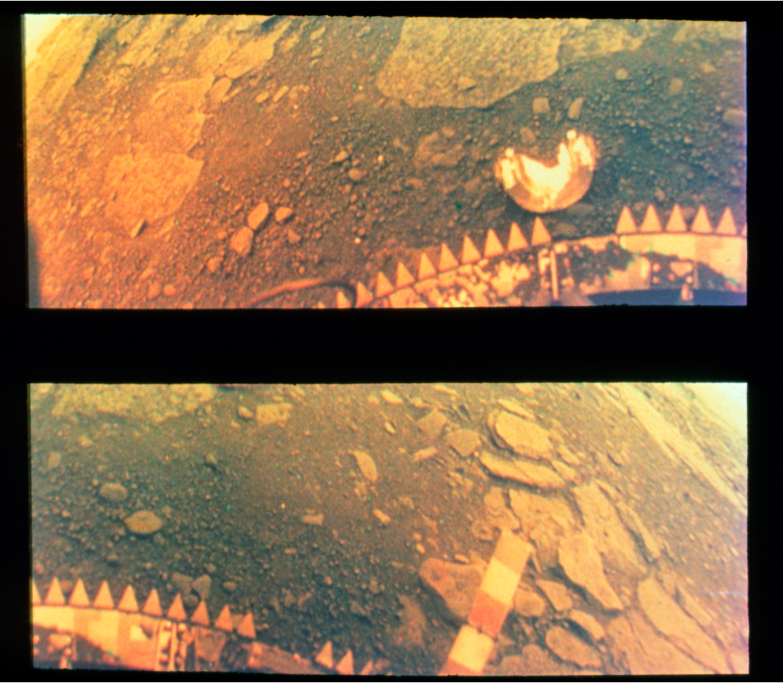
© SPUTNIK / SCIENCE PHOTO LIBRARY
In March 1982, Venera 13 returned these photographs of the surface of Venus, with part of the spacecraft visible in the foreground.
Despite multiple failures, the Soviets didn’t give up and in October 1967 Venera 4 entered the atmosphere of Venus and sent back data supporting the Earth-based observations, revealing for the first time that the blanket of cloud surrounding Venus was made up of primarily carbon dioxide (90 to 95 per cent), 3 per cent nitrogen and just trace amounts of oxygen and water vapour. Venera 4 confirmed beyond all doubt that this was no second Earth: as it descended through the thick clouds, the temperature rose to 262 degrees Celsius, the atmospheric pressure increased to 22 standard atmospheres (2,200kpa) – and this was still 26 kilometres above the surface. As Venera 4 parachuted its way down to the surface it provided data back to Earth while confirming its own imminent death. This was a spacecraft that was not designed to survive the intense pressures and temperatures it was measuring, let alone the lack of the water landing it was designed for. The craft failed during the descent and was lost long before it reached the surface.
Gradually, through the following missions, the Soviet scientists began to overcome each and every challenge Venus put in front of them. Venera 7 was built to survive the most violent of landings, and even though its parachute failed, it made it to the surface intact in 1970 and was able to use its damaged antennae to transmit limited temperature data for 23 minutes before it expired.
Venera 9 not only made it to the surface and operated for 53 minutes in October 1975 but was also the first craft to successfully deploy its camera on the ground and transmit an image back to Earth. In the first-ever picture taken from the surface of another planet, the black and white fractured image revealed a rocky, desolate landscape with measurements confirming it to be a blistering 485 degrees Celsius, with an atmospheric pressure of 90 atm (standard atmosphere) crushing down.
By the time Venera 13 launched, on 30 October 1981, the ambition of the missions and the confidence in delivering data from the surface had been radically transformed. Venera 13 functioned for 127 minutes in recorded temperatures of 457 degrees Celsius and a pressure of 89 Earth atmospheres. The probe’s cameras deployed, taking the first colour image from the surface of Venus, spring-loaded arms measured the compressibility of the soil, while a mechanical drill arm took a sample of the Venusian surface that was analysed by an onboard spectrometer. If that wasn’t enough, onboard microphones were deployed to record the vicious winds that were assumed to be whipping the surface of Venus, the first-ever recording of the sound of another planet.
As the Venera missions came to a close in 1983, not even the smallest doubt remained of Venus’s hostility. Far from the benign water world we had once imagined, the reality was that this was not a sister we recognised – in our search of the heavens for a place like home we’d found a toxic, fiery hellscape.
Venus is an enigmatic world – almost Earth-like in size, position and potential, and yet as far from paradise as it’s possible to imagine. If Mercury’s story is one of catastrophic orbital change and Earth’s of balance and stability, the story of Venus is a tragedy; a tale of subtle, yet relentless decline. So why did it all go wrong for Venus? Why did a world born with such similarities to the Earth take such a different path? To answer that, we need to look beyond the tortured planet we see today and go back to a time when Venus was a young thriving planet.
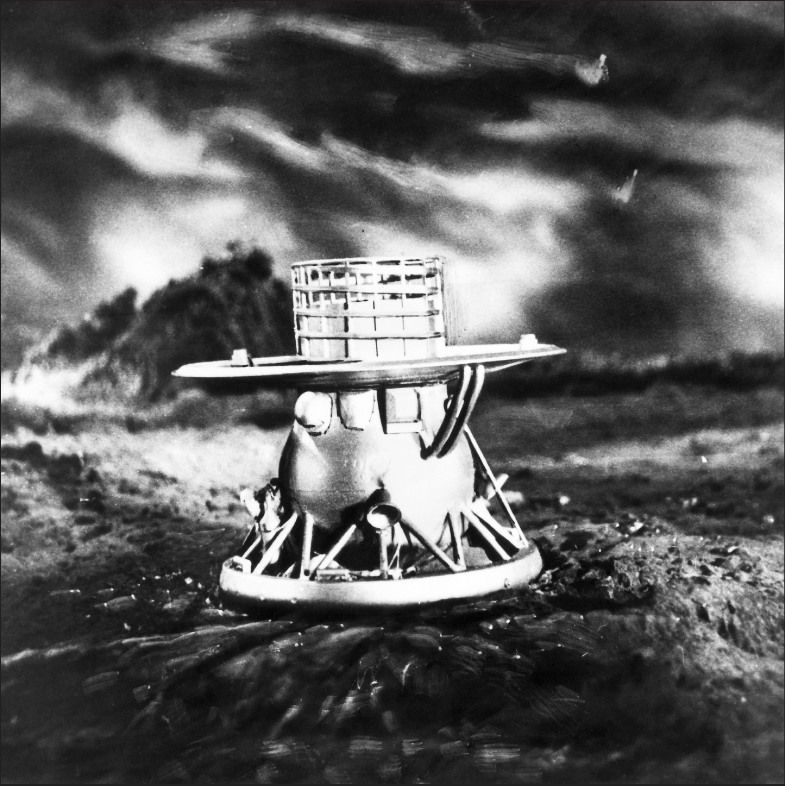
© SPUTNIK / SCIENCE PHOTO LIBRARY
Soviet scientists worked hard on the Venera missions, tweaking the spacecraft at every new incarnation, to get more time to explore Venus’s hostile landscape. This is a model of the Venera 9 spacecraft.
Through the following missions, the Soviet scientists began to overcome each and every challenge Venus put in front of them.
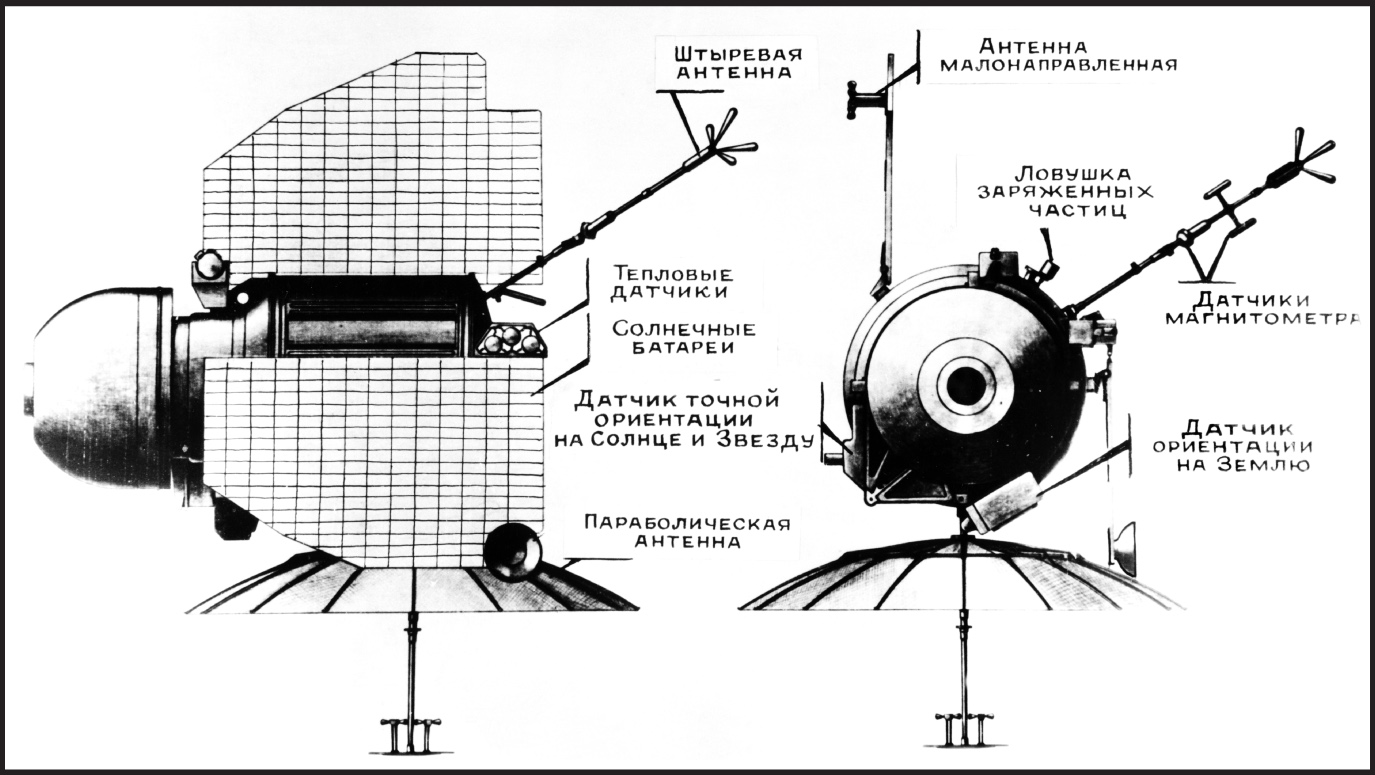
© Sovfoto/UIG via Getty Images
A diagram of Venera 1, the first mission.
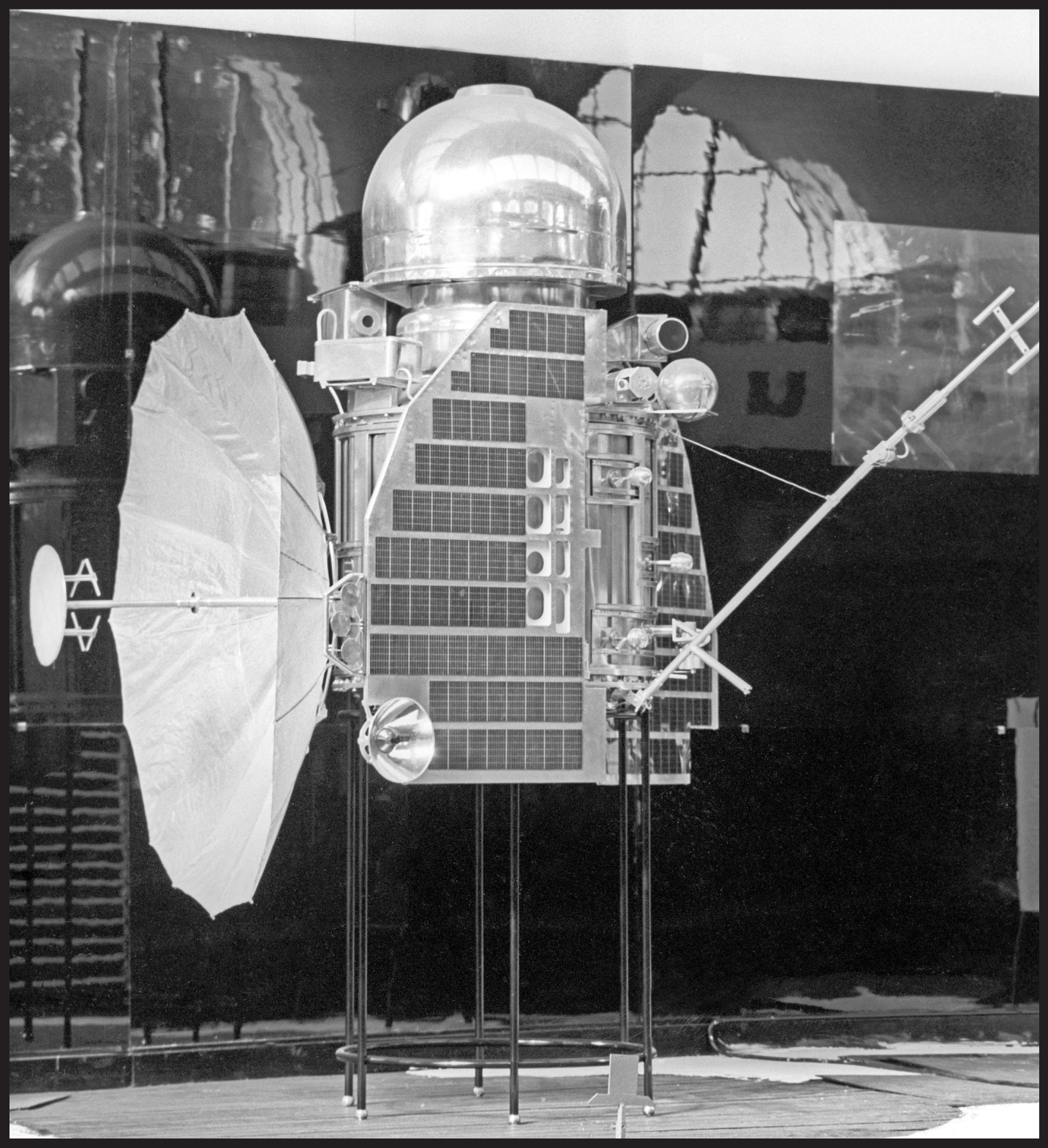
© SPUTNIK / SCIENCE PHOTO LIBRARY
The Venera 1 display in the space (Kosmos) pavilion at the All-Russia Exhibition Centre, in Moscow, Russia.
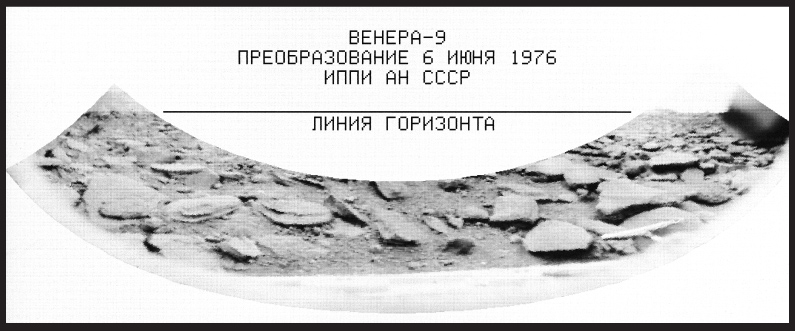
© SPUTNIK / SCIENCE PHOTO LIBRARY
This radar image taken by Venera 15 and 16, offers a fascinating insight into the terrain of Venus, revealing the Maxwell Montes mountain range in the centre and the 100-km-wide Cleopatra crater.
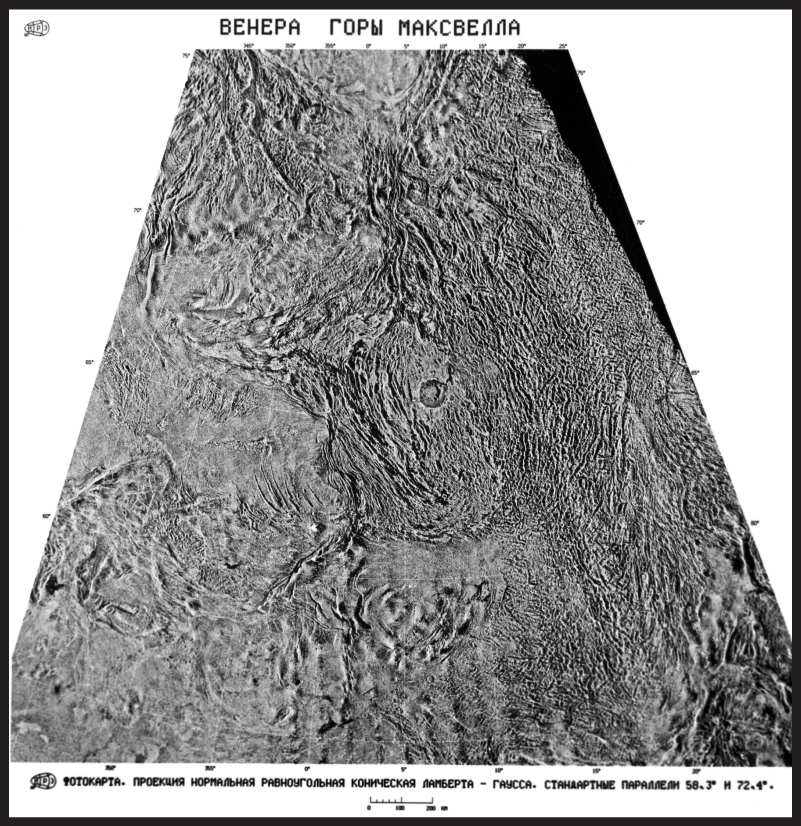
© SPUTNIK / SCIENCE PHOTO LIBRARY
Sediment and rocks visible on the landscape, imaged by Venera 9.
THE BIRTH OF VENUS
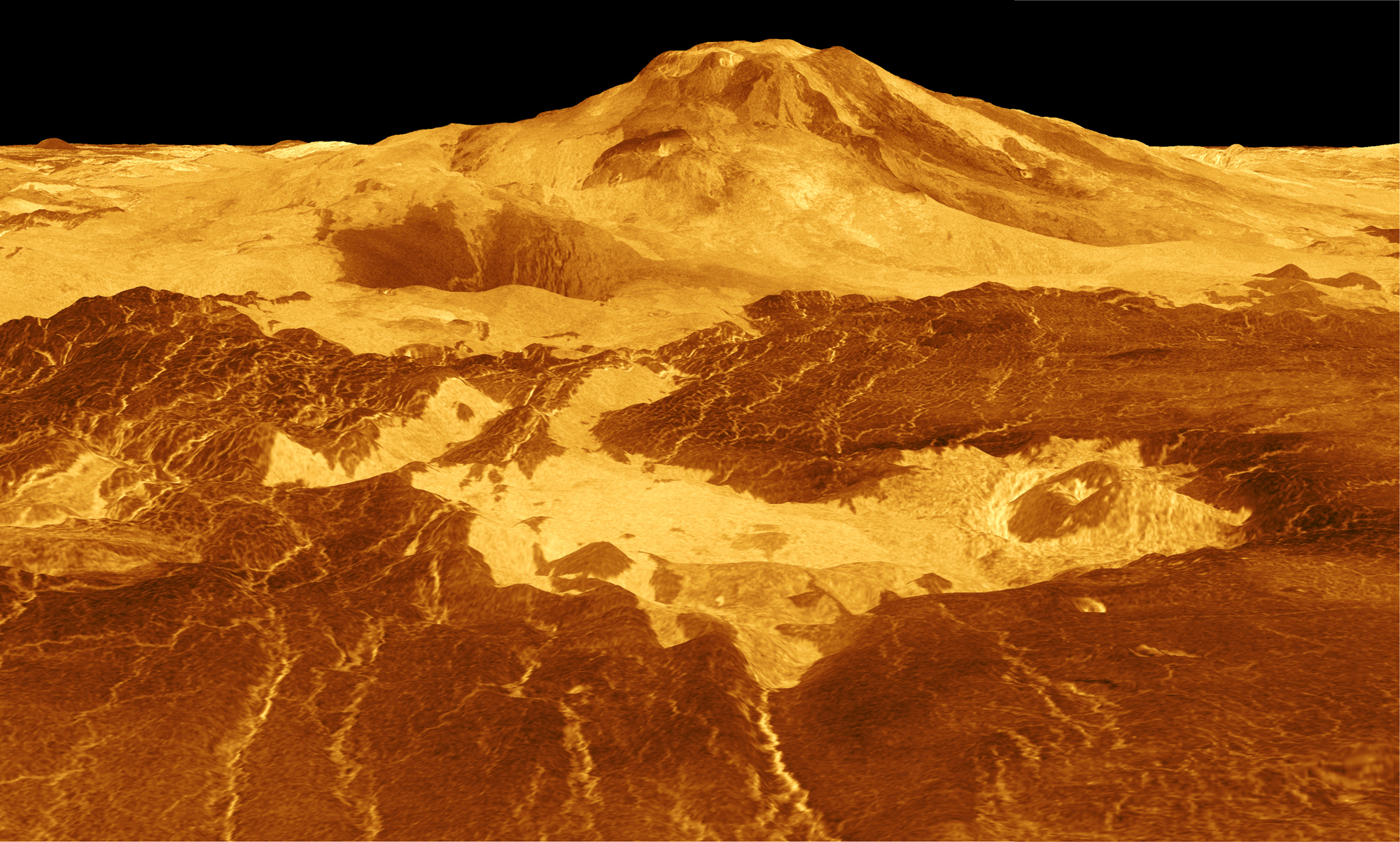
© NASA/JPL
Rising centrally in this computer-generated image is the volcano Maat Mons, surrounded by cascading lava. This three-dimensional image was created using data relayed by Venera 13 and 14.
‘Today Venus is incredibly hostile … so hot, so dry, but what did it start out like, was it ever more Earth-like? We don’t know for sure, so we want to make future spacecraft missions to nail down that early history.’
David Grinspoon, astrobiologist
Four billion years ago, Venus was a familiar world. A world created from the same dust as the Earth, born just about the same size and settled into an orbit that seemed just far enough away from the glare of the Sun to allow a precious process to begin to take hold. In almost every conceivable way, Venus’s early life mirrored that of our own world. As its newly formed crust settled and cooled from the violent heat of its birth, an atmosphere began to grow around the young planet, fed by gases bubbling up from the molten rock below its surface, as well as captured from the clouds of gas and dust it swept through on its orbit around the Sun. Clinging to the young Venus, this thin layer of gas would have certainly contained nitrogen, oxygen and carbon dioxide, but most intriguing of all, we are certain it would have also contained large amounts of water vapour.
High in the Venusian atmosphere this water vapour eventually cooled enough to change state from vapour to liquid. And with that transformation, a process began, that perhaps for the first time on any of the planets would have seen the conditions become just right for droplets of liquid water to take shape and begin falling from the Venusian sky. These were the first rains of the Solar System, showering down onto the dry plains of Venus. Gradually these rains would have not just fallen but flooded the surface, rivers would have flowed and shallow oceans taken hold of large swathes of the planet’s surface. Venus, perhaps before even the Earth, became a water world, a planet with skies full of clouds and a surface full of oceans, feeding the cycle of water around this young planet.
How can we be certain this blue version of Venus existed? Unlike Mars, where we can see the evidence of its watery past etched onto its surface, we have no such direct evidence of the presence of liquid water on the surface of Venus. The only physical evidence we have suggests that the planet’s watery past comes from measurements taken by NASA’s Pioneer Venus spacecraft back in 1978. One of its most surprising discoveries revealed an unexpected amount of deuterium (heavy water) in the atmosphere compared with hydrogen. This D/H ratio is far smaller on Venus than it is on Earth, and that’s interesting because when the two planets formed the ratio would have almost certainly been the same. Because hydrogen is far more easily lost from an atmosphere than deuterium, this smaller ratio suggests that Venus has lost a lot more water than the Earth over its lifetime – the signature of a long-lost primordial ocean. As cosmochemist Larry Nittler explains:
‘Scientists believe that Venus once had a lot of water in its oceans, but lost it over time, and perhaps in oceans as recently as a billion years ago. The reason we can tell this is from the isotopic composition of hydrogen measured in its atmosphere by spacecraft. Now, hydrogen has two flavours of isotopes, whereas most hydrogen atoms are just a single proton in the nucleus. Some, a small fraction, are what we call deuterium, that have a proton and a neutron, so they weigh twice as much as the regular hydrogen. What happens when you have evaporation of water from a planet, or the atmosphere, is that the water molecules that contain hydrogen are much lighter than the water molecules that contain deuterium, so they evaporate more easily, and can be lost more easily. So, over time, as you evaporate water, deuterium-bearing molecules stay behind relatively to the regular ones, and you build up a deuterium to hydrogen ratio. And by back-calculating from the measured ratio today, we can figure out how much water has been lost over the billions of years of evolution, and [on Venus] it’s quite a lot.’
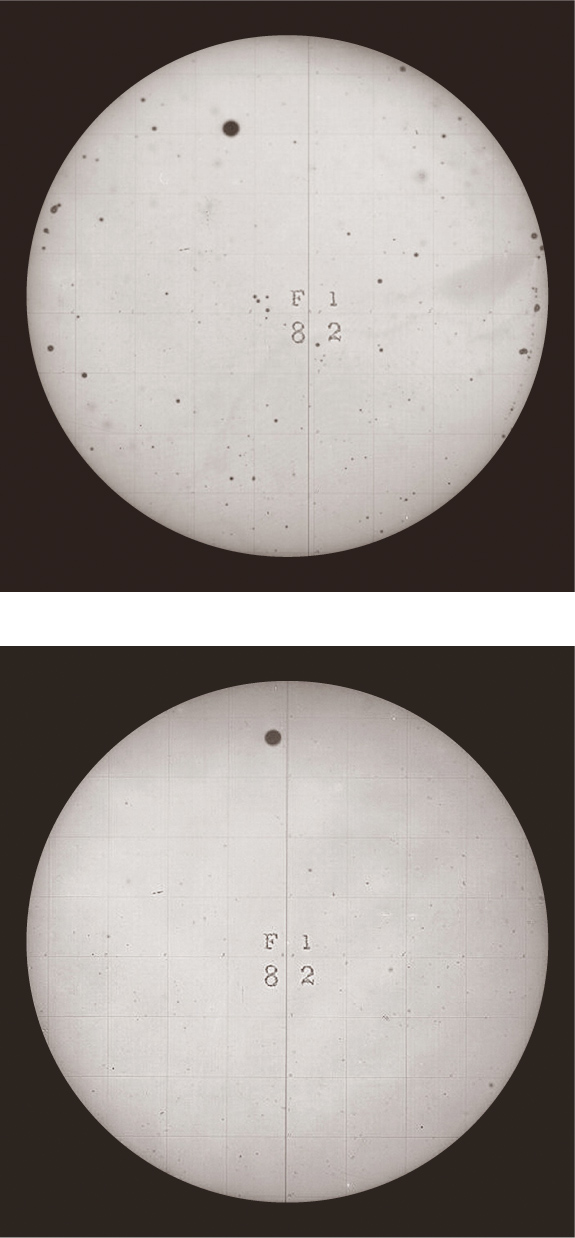
© United States Naval Observatory
The transit of Venus – as the planet crosses the face of the Sun – was captured in photographic plates as early as 1882.
None of this is solid proof, but it does begin to point us in one direction, and with no further exploration of the surface we have had to rely on an accumulation of indirect evidence to begin to paint a more detailed picture of Venus’s watery past.
As with almost all of our understanding of the planets, the evidence that built this picture has been accumulated through decades of exploration. Starting with the Venera missions’ first touchdown on the planet to the Pioneer Venus orbiter, and to the more recent Magellan mission, which not only relayed extraordinary radar soundings of the surface of Venus but provided the first full topographical map of the planet collated over a period of four years in orbit.
Combining all of the data that has been accumulated over decades of exploration has allowed us to peer deep into the planet’s past, using the same tools that enable us to model the future of climate change here on Earth to create climate models of Venus in the past, present and future. The results of this analysis, conducted most recently by a team from NASA’s Goddard Institute for Space Studies (GISS), all point to the same conclusion – in the distant past Venus was a planet covered in shallow primordial oceans.
Some estimates suggest this water world was far from fleeting, a blue planet just like our own that could have been sustained for around 2 billion years and perhaps only disappeared some 700 million years ago. It’s a tantalising thought that such a similar world to our own existed for so long with liquid water on its surface. We know life took hold quickly on our own blue planet, within half a billion years of the Earth being formed, so there seems good reason to suspect that if Venus really was as wet as the models predict, it too could have sprung into life. Exactly what went on in the long-lost rivers and oceans of Venus is yet to be discovered; hidden behind the clouds, we have not yet been back to search for any signs that life ever took hold here. Our exploratory attentions have turned to Mars as a planet that not only has a fertile past but is also a possible target for human colonisation in the future. We know for certain that no life (at least no life we understand) could exist on Venus today, and perhaps even the evidence of any biology on that long-lost water world has long ago vanished under the oppressive heat, rampant volcanism and extreme pressures of the planet today. So where did all that water go? Understanding this requires an exploration of the differences between Earth and Venus, as well as the similarities.
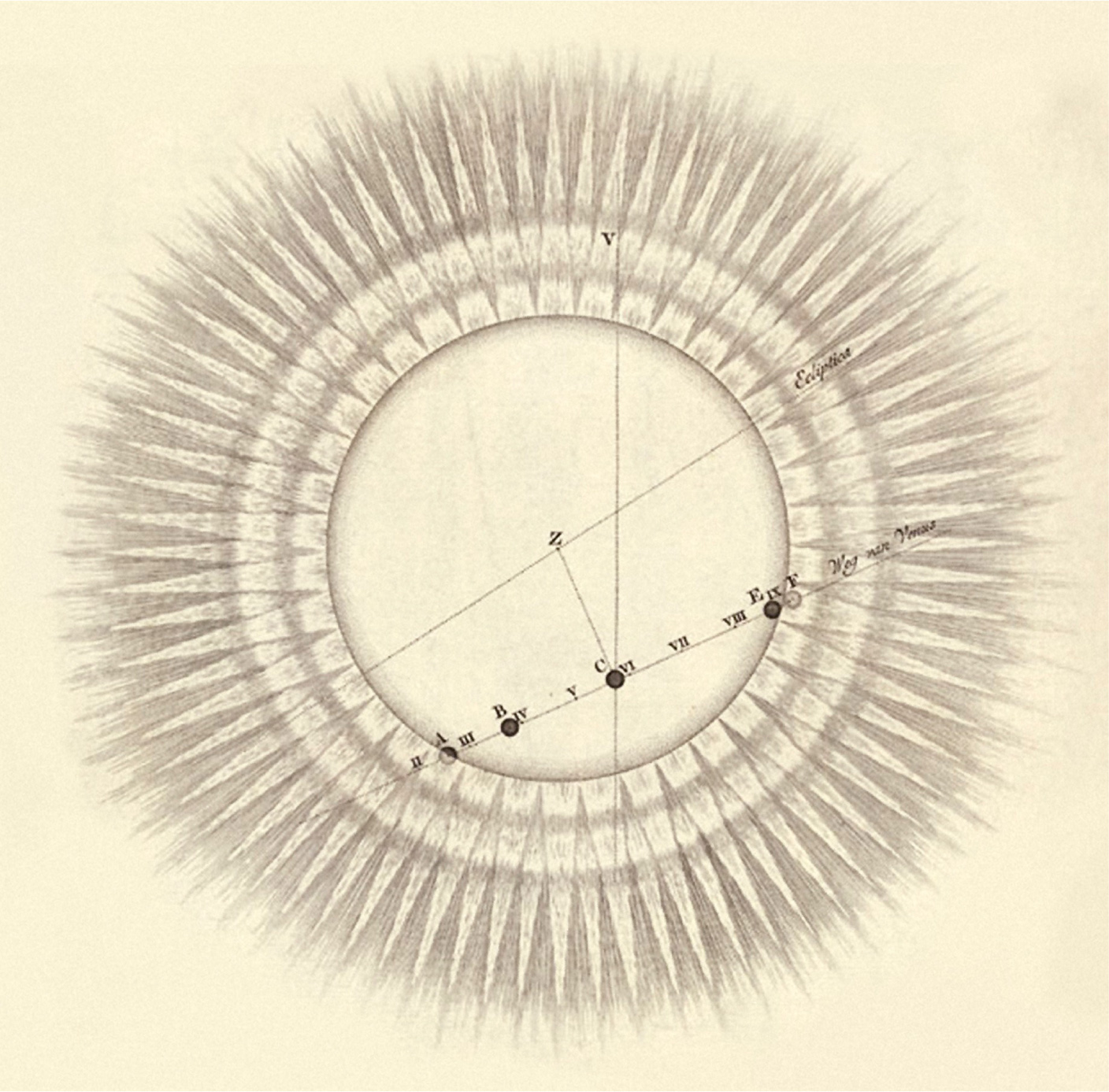
© LIBRARY OF CONGRESS / SCIENCE PHOTO LIBRARY
Venus has fascinated scientists for centuries; this diagram was drawn by Nicholas Ypey in 1761, showing the transit of Venus that year.

© United States Naval Observatory
Catching a glimpse of the transit of Venus is rare and has been important throughout the centuries. The next such sightings are predicted for 2117 and 2125. Recording each transit is vital research, which helps scientists to determine the scale of the Solar System.
‘Oh most grateful spectacle, the realisation of so many ardent desires.’
Jeremiah Horrocks, seeing the transit of Venus in 1639
Today Venus has the slowest rotation of any planet in the Solar System, taking 243 Earth days to complete one rotation on its axis. This period is known as the sidereal day, which is different to a solar day – the time it takes for the Sun to return to the same point in the sky. On Earth the sidereal day, at 23 hours, 56 minutes and 4.1 seconds, is very close to the solar day, which lasts pretty much exactly 24 hours. But on Venus the difference between these two periods is much greater. Even though the planet takes 243 days to rotate on its axis when combined with its orbit, a solar day on Venus lasts for 116.75 Earth days. It means every day on Venus lasts almost four months on Earth, and not only that, but Venus also rotates from east to west (one of only two planets to do so, along with Uranus). So across this toxic world a sunrise would last literally for days as it inches across the sky.
This slow progression of the Sun in the Venusian sky, due to the planet’s creeping rotation, has raised many questions about how in the past the planet would have been heated and how the climate would have been affected by such a different rotation compared with the Earth’s. Today the climate of Venus is what is known as isothermal – there is a constant temperature between the day and night sides and between the equator and the poles. This is because the thick atmosphere literally acts like a blanket, dissipating the heat of the Sun so that the only real variation in temperature on the Venusian surface occurs due to differences in altitude. In its past, however, this may have been very different – with a more Earth-like atmosphere, so the Sun would have been beating down on the planet’s surface for days on end.
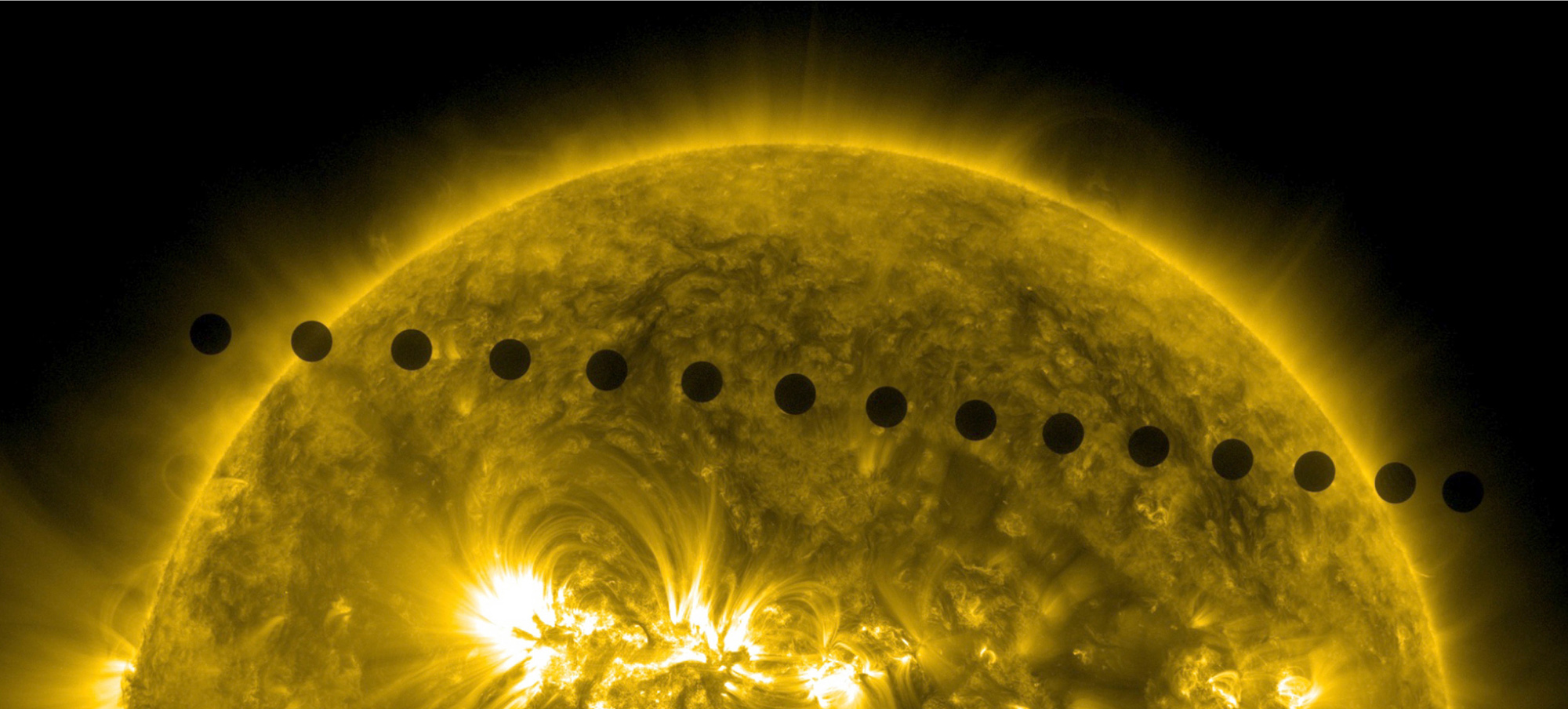
© NASA / GODDARD SPACE FLIGHT CENTER / SDO / SCIENCE PHOTO LIBRARY
Composite image showing the transit of Venus in June 2012 (in black spots).
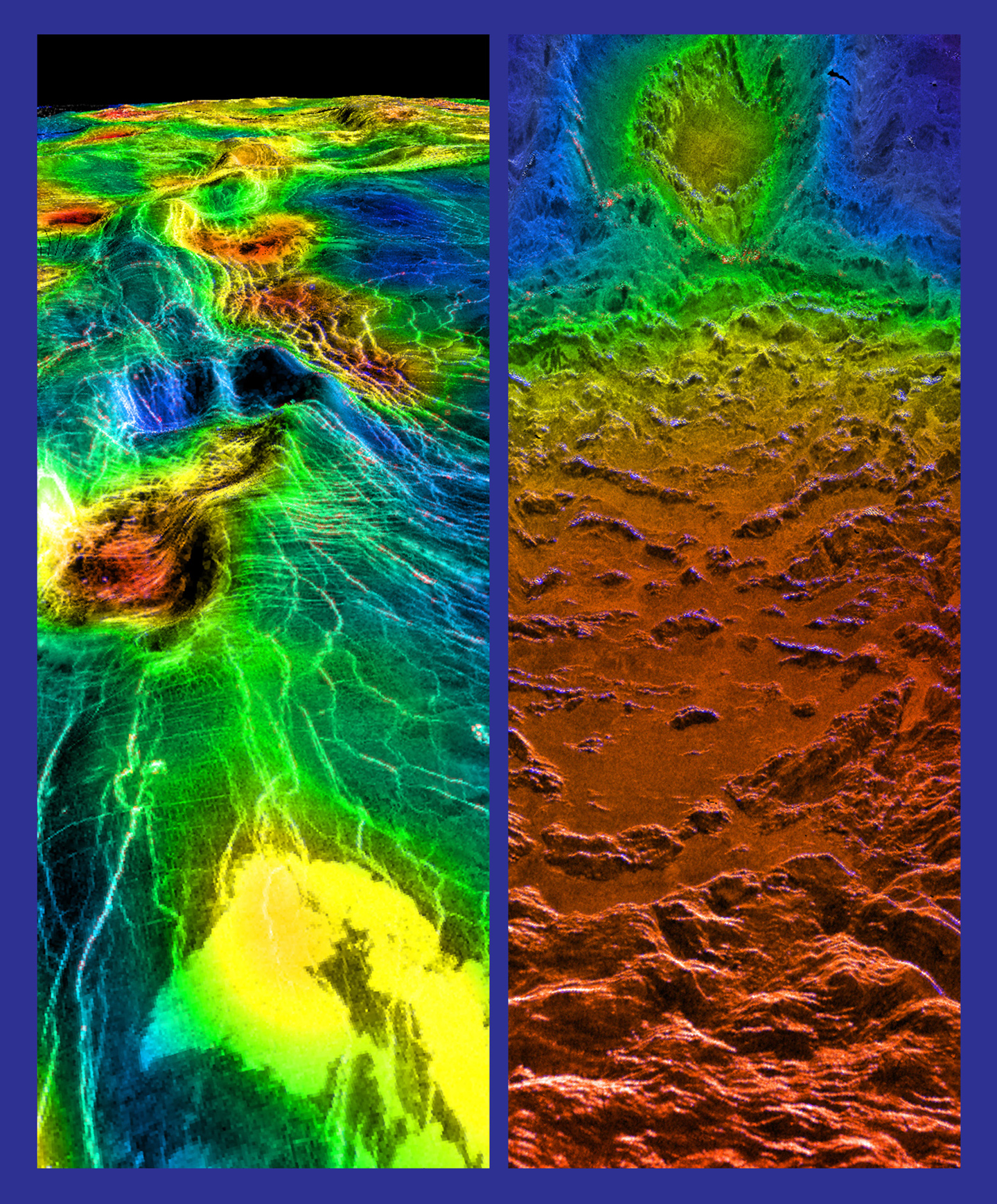
© NASA/JPL/USGS
NASA’s Magellan mission in the 1990s sent back images of Venus that enabled scientists to create a more detailed image of the landscapes of this long-lost world. They revealed a terrain of lowlands and highlands, dotted with active volcanos – a far cry from the ancient watery Venus imagined and depicted in some artworks.

© NASA
‘In the GISS model’s simulation, Venus’s slow spin exposes its dayside to the Sun for almost two months at a time. This warms the surface and produces rain that creates a thick layer of clouds, which acts like an umbrella to shield the surface from much of the solar heating. The result is mean climate temperatures that are actually a few degrees cooler than Earth’s today.’
Anthony Del Genio, planetary scientist
To make things even more complex, we know the spin of a planet is intimately linked to its climate and we’ve got strong evidence to suggest that how fast a planet spins is directly related to its chance of habitability. Until very recently it was assumed that the slow rotation of Venus must have been caused by the presence of a thick atmosphere early on in its history that in effect acted as a brake on the planet’s spin. However, recent studies now suggest the planet could have had a thin atmosphere like that of modern Earth and still have ended up with its slow rotation.
Gradually, as we start to build a picture of ancient Venus we begin to see beyond the cloud cover of today through to an ancient planet with an Earth-like atmosphere, and a day lasting over 200 Earth days as the Sun beat down on the ocean-covered surface.
To make sense of the climate of this Earth-like Venus, the team at the Goddard Institute needed to make another tweak (or postulation, to be more precise) to the model. With the Sun hitting the one side of the surface for so much longer than on the Earth, the evaporation rate of the oceans would be far greater and potentially incompatible with the water world we suspect existed, but by simply adjusting the amount of dry land on the surface of Venus, especially in the Tropics, the effect is dramatic. With a higher percentage of land, the models suggest that even the slow rotation would not dry out the planet, and it could have held on to enough water to be ripe for supporting the emergence of life.
By combining all of this data, the GISS team have painted our most up-to-date picture of early Venus, and it’s a beguiling image. Within the infant Solar System, it is a planet the size of Earth with a similar atmosphere to the one we see today. On Venus days lasted for months as the Sun arced slowly across the sky from west to east, rising and setting over a vast, shallow ocean.
Finally, the data from radar measurements taken by NASA’s Magellan mission in the 1990s was used to paint the last brushstrokes of this long-lost world. Filling in the lowlands with water, the topography of this ancient world emerges with the highlands exposed as the Venusian continents. It all points to the possibility that Venus could have been the first habitable world in our Solar System. So what changed? To find out we need to look not just at the planet in isolation but also at the star around which it orbits.
GOODBYE TO LIFE
No planet lives out its life in isolation. Venus, like all the planets is part of a Solar System, a system that is driven more than anything else by the star at its centre. Today the Sun burns bright in our skies, bathing our planet in just enough starlight to keep the oceans from freezing, but not too much to boil them away. Earth lies in the sweet spot we call the Goldilocks zone, but as we have already seen in this chapter, nothing in the Solar System is forever and what we see today is not what we will see tomorrow nor what we would have seen yesterday.
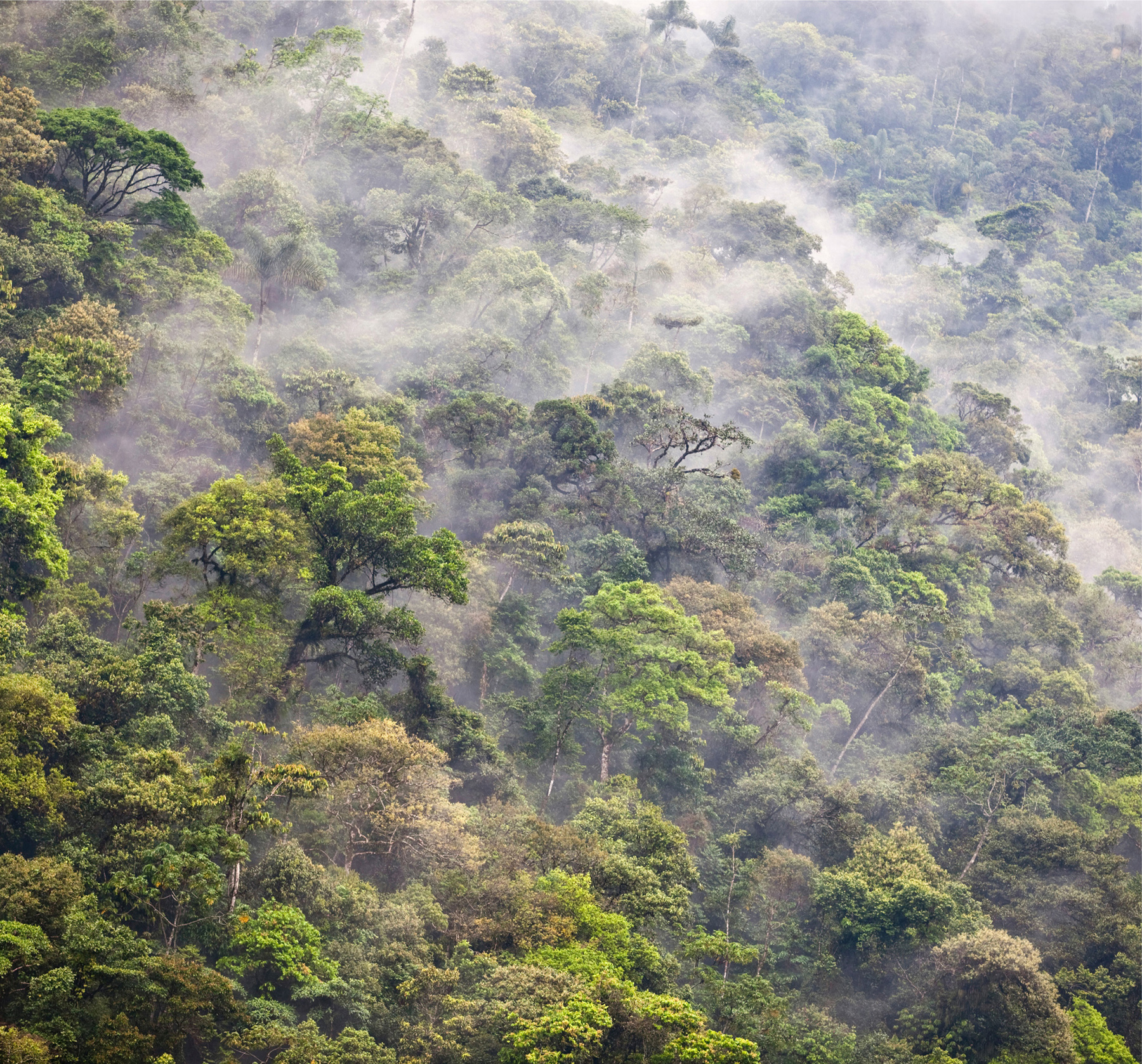
© frans lemmens / Alamy Stock Photo
Capturing the Sun’s warmth is essential for life on a planet, but when too much heat is trapped it can have devastating consequences.

© NASA/JPL-Caltech, Illustrations by Jessie Kawata
David Grinspoon, astrobiologist, on Venusian life:
‘So when we say, as we often do, that Venus is completely uninhabitable, we should put a little asterisk next to that statement, because, we’re talking about the surface environment. But actually if you go up from the surface about 50 kilometres you reach a zone that may be habitable on Venus; in the clouds the pressure and temperature is roughly what it is here on the surface of Earth. There are energy sources in terms of radiation and chemical energy, there are nutrients, there is even liquid water medium – although it’s concentrated sulphuric acid in the clouds – but we now know of organisms on Earth that love concentrated sulphuric acid. So there’s nothing to rule out life in the clouds of Venus and there are even some, I would say circumstantial, facts that suggest the possibility of a biosphere there. I wouldn’t bet on life in the clouds of Venus, but I wouldn’t rule it out until we’ve explored a little more carefully.’
As our Sun gets older, it’s gradually burning hotter and hotter. This is because as it ages the process of nuclear fusion – the fusion of hydrogen into (mainly) helium – gradually leads to an increase in the amount of helium in its core. This rise in helium causes the Sun’s core to contract, which in turn allows the whole star to shrink in on itself, creating an increased pressure that results in a rise in the rate of fusion, and so the energy output of the Sun goes up. If tomorrow the Sun is burning hotter than today, it of course makes sense that in the early days of the Solar System our Sun burned far less brightly. It’s a life cycle that is common to all main-sequence stars, the category of star that includes our Sun, and as the most common type of star in the Universe we have been able to study this life cycle in intimate detail, allowing us to make immensely detailed predictions about the characteristics of our Sun in the past and in the future.
Winding back the clock, the current consensus amongst astronomers is that 4 billion years ago the faint young Sun was at least 30 per cent dimmer than it is today. This cooler Sun would have undoubtedly had a big impact on all of the terrestrial planets. Earth would have been much colder, and as it was receiving far less solar energy it remains something of a mystery as to why our planet wasn’t frozen solid. Instead, at this time on Earth first life was just beginning, in the liquid water that we are pretty certain covered its surface.
At the same time, 3.5 to 4 billion years ago, the young Sun would have bathed Venus in a warmer glow. This ocean world found itself in its very own sweet spot, a world held in a delicate balance. With the Sun weakened and restrained, the Earth-like atmosphere of Venus could act as a gentle blanket, keeping the surface temperate and covered in an abundance of liquid water. But even with this additional solar energy we think Venus would have been cooler than the Earth is today; in fact we believe temperatures at that time would have been like a pleasant spring day here on Earth.

